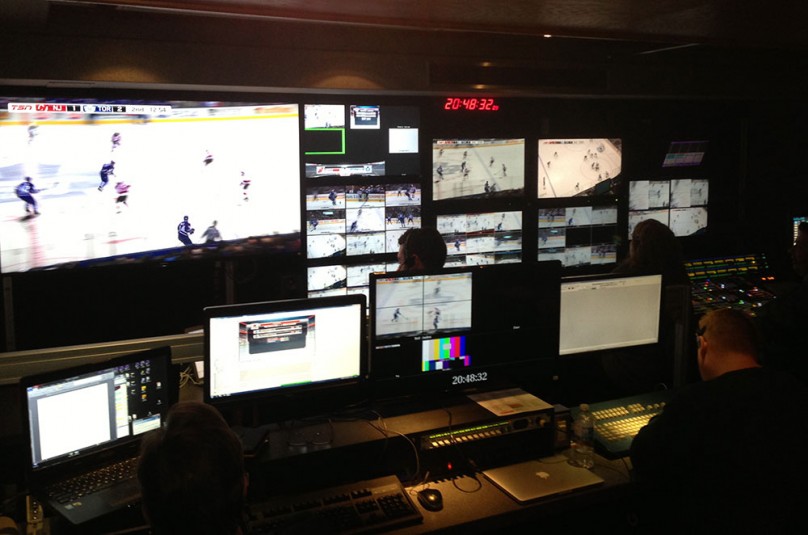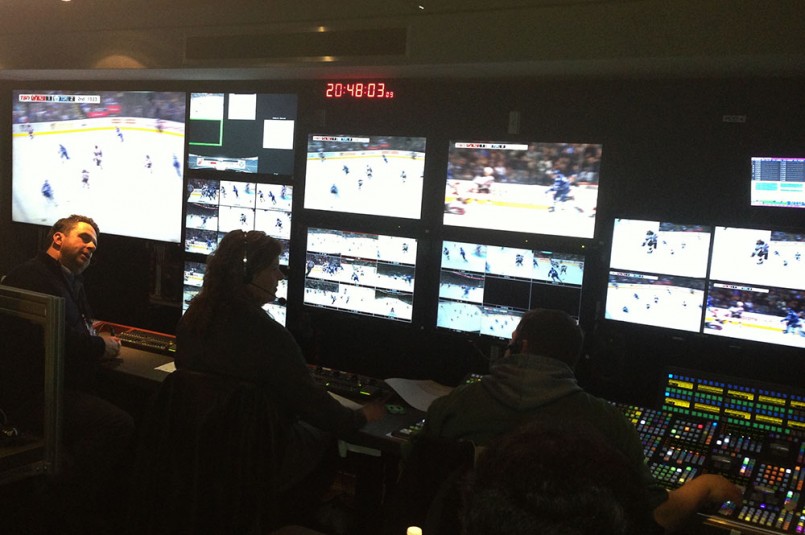Dome Productions Preps for Arrival of Live 4K Sports in Canada
The mobile-unit provider is set to launch HD/4K and dedicated 4K trucks this year to serve the 100+ live 4K sports productions planned by Rogers and Bell Media in 2016.
Story Highlights
The live 4K UHD sports boom arrives in Canada this month, and Toronto-based mobile-unit provider Dome Productions is ready with multiple 4K trucks set to launch over the next six months.
Both of Dome Productions’ owners — Rogers Communications and Bell Media — will begin producing and delivering NBA and NHL games live in 4K to their respective subscribers this month, and Rogers plans to produce all 81 Toronto Blue Jays MLB home games in 4K with HDR beginning this spring. With that in mind, Dome Productions will roll out a side-by-side HD/4K mobile production unit next week to serve both companies’ immediate production needs and is set to launch a single-trailer HD/4K hybrid trucks in both March and July.

Dome’s Unite mobile unit has been transformed into a 4K/UHD truck to serve the growing number of live 4K sports productions set for 2016 from Sportsnet and TSN.
“The unique part about Dome Productions is our owners,” says Dome Productions SVP/GM Mary Ellen Carlyle on why Dome has leaped out in front of the 4K-production curve. “I think that, because they are trying to figure out how to sell more set-top boxes and survive in this new world, they have come to us with very big challenge. And, because our engineering group is innovative and, I believe, the best in the business, we were ready to go. So they just pulled the trigger, and we have been able to do it.”
Although Rogers’s Sportsnet delivered its first live 4K telecast — the Toronto Raptors-Orlando Magic NBA game from London’s 02 Arena (in conjunction with BT Sport and the NBA) — its first production within Canadian borders will take place on Jan. 23, when the Montreal Canadiens visit the Toronto Maple Leafs at the Air Canada Centre (ACC), with another 20-plus NHL shows and 81 Blue Jays games to follow this year. For its part, Bell Media’s TSN launches its live 4K offering on Jan. 20 with the Raptors-Boston Celtics matchup and a full slate of 4K broadcasts featuring the Raptors, Maple Leafs, and Ottawa Senators.
Dome To ‘Unite’ 4K and HD With Side-by-Side Units
Dome Productions has acted quickly since Rogers announced its plans in October, opting to transform its Unite double-expando mobile unit (previously a CAMERON|PACE Group 3D truck) into a dedicated 4K truck that will serve alongside the primary HD mobile unit for NHL and NBA productions in the near term. Dome conducted a proof-of-concept with Sportsnet during a CHL game in London, ON, on Dec. 4 and another with TSN on Dec. 8 during the Maple Leafs-New Jersey Devils matchup. This side-by-side 4K/HD production model will have a full rehearsal at Sportsnet’s Chicago Blackhawks-Maple Leafs game tonight at the ACC and then will go live for Sportsnet on Jan. 23.
Ten Sony HDC-4300 cameras (outfitted with Canon UHD lenses), which can output both HD and 4K concurrently, make this side-by-side workflow possible. In addition, HD robos, net cams, and overhead cameras will be upconverted to 4K.
“Since the launch was so quick, we had to figure out some workflows just to get them on the air, and, believe me, we changed our minds daily,” says Carlyle. “In the end, we decided to go with Unite as a side-by-side 4K truck, and we are doing a shadow cut, so, when the director in the main truck takes camera two, we take camera two.”
With a Grass Valley Kayenne K-Frame switcher on the Unite truck, she adds, the technical director faces one of the largest learning curves of any operator in the truck, having to deal now with four quadrants instead of one.
“4K is a big payload, so it’s imposing on the switcher,” says Mike Johnson, director of engineering, Dome Productions. “We’ve had to adjust the things that we can do on the switcher in terms of layering and how many channels of keying we can do. So that’s an imposition, but the manufacturers are working on that; they’ll come around.”
In addition, Dome has upped Unite’s complement of EVS XT3 replay systems and operators, since the number of replay channels are essentially cut in half in a 4K production.
“We’re still working through a lot of that replay workflow,” Johnson adds, “but, for example, if you had a six-channel replay station with four inputs and two outputs, it takes three frames to do that in the UHD world. So we have had to get creative in terms of how we use our [replay resources] and operators to try to make it as similar to an [HD show] as possible. … But, at the same time, just like 3D, we didn’t want to size up the crew too much.”
ChyronHego HD graphics will also be upconverted for the 4K show.
Delivering 4K to the Home
Dome’s cross-Canada fiber network will serve as the backbone for transmission services for both Sportsnet and TSN 4K telecasts. Dome began testing 4K transmission over its fiber in December 2014 and delivered live 4K and 8K content from the Women’s World Cup last summer for Japanese broadcaster NHK. According to Johnson, Dome will use a mix of J2K, MPEG-2, and MPEG-4 compression schemes and deliver the 4K signal over an assortment of 10-gig and 1-gig circuits.

TSN’s NHL 4K rehearsal inside Dome’s Unite 4K truck at the Air Canada Centre on Dec. 8 during the Maple Leafs-Devils game
“[With] 4K transmission, instead of one encoder, you need four encoders and add a spare to that,” he says. “And the same thing on the other end: you need multiple decoders to move the signal around.”
Trillium on the Way
The 4K/HD side-by-side model is only a temporary solution, however. Dome is currently revamping its Trillium mobile unit as a standalone 4K/HD hybrid production truck (intended for Blue Jays games) in March. Trillium will produce a 4K show and then downconvert to create the HD feed.
The overhauled Trillium mobile unit already features a Grass Valley Kayenne switcher and Trinix router and will also use Sony HDC-4300 HD/4K cameras. It will roll with a pair of B units, one for the HD show and the other custom-designed to carry all the UHD infrastructure. The UHD B unit will house a large UHD baseband router, as well as the Grass Valley K-Frame infrastructure for the Kayenne switcher and replay-system infrastructure.
“We are basically adding a UHD core layer to an existing truck,” says Johnson. “We can control the router and service the replay channels to feed to the stations in the A unit, so the heavy lifting of 4K all takes place in the B unit. In terms of connecting it to the A unit, we just have to tie into the operator-station links, so there are multiviewer video displays and audio monitoring, and that will all link through fiber interconnects back to the B unit and will control the devices.”
Trillium is scheduled to be completed on March 7, with rehearsals planned on April 1 and 2 for the Blue Jays final two spring-training games against the Boston Red Sox in Montreal and then a debut at the home opener on April 8, also against the Red Sox.
A Dedicated Truck Set for Summer
In July, Dome will take its next big 4K leap with a purpose-built 4K mobile unit, which will also be HD-capable. The trailer is currently being built by Gerling & Associates, with Unity Systems Integration serving as integrator. This truck will serve NHL coverage primarily, with Trillium remaining home to Blue Jays productions.
Although equipment details are sparse at this juncture, Dome has made one key decision: the truck will feature an IP router. However, the specific router has yet to be determined.
“The model of IP certainly helps you get up to the capacity. If you’re going to deal with either 4K as a 12-gig signal or a [quad] 3-gig signal, you really need that kind of I/O to help you out,” Johnson explains. “Right now, a 512×512 router becomes a 144×144 for 4K in terms of traditional SDI point-to-point cabling. But, if we can get to that IP infrastructure, that would certainly do a lot better with the capacity. We’re working hard to try and establish what that solution will be.”
Dome has also elected not to commit to a replay platform but will spend 2016 evaluating multiple solutions, including EVS XT3, Evertz DreamCatcher, Grass Valley K2 Dyno, and Sony PWS-4500.
“We decided not to purchase UHD replay systems at this point in time because we want to evaluate all there is out there and we are not going to purchase until January next year,” says Carlyle. “The reason we’re doing that is we have to downconvert to HD when we roll to another truck anyway. Right now, if do the Jays in Boston, for example, we are not doing those games in 4K. So, since we’ve got to do something different anyway, we want to keep our options open.”
HDR on the Horizon
Rogers has committed to present all 81 Blue Jays home games on Sportsnet not only in 4K but also with HDR. Johnson has found what so many others exploring live HDR production have thus far: although an HDR camera fed directly to an HDR monitor is rather simple and looks spectacular, the other points in the live-production ecosystem complicate matters exponentially.
“When you start to blend in all the other contributions and paths beyond the camera and display, it starts to present real challenges,” he says. “What does it mean for pulling up the archival material? Blue Jays home-show melts are going to be UHD, and, if they are HDR as well, what does that mean when we go on the road? What do the pictures look like when we bring it into the road show? And, vice versa, what does it mean when I bring the road-show elements and I start to introduce those to the home show? And then, in terms of transmission down the line, what happens in master control?”
As is the case with all next-gen technologies, the HDR-standards conundrum presents yet another challenge. Currently, Dome is exploring the HDR-10 media profile and HLG (Hybrid Log Gamma), but each presents its own set of issues.
“Probably the biggest thing is that there’s really only one truly complete definition for HDR, which is HDR-10. The [film industry] can work with that right now, but it doesn’t fit very well in the live-event world because we don’t have all the necessary tools right now. We are looking at other HDR solutions like HLG, but, when it comes to delivering [4K HDR] via the set-top box and signaling from the set-top box to the monitor, the HLG path wouldn’t necessary have that capability. We are working towards a solution to make all that happen.”
